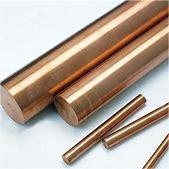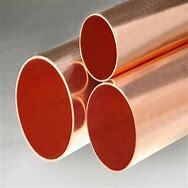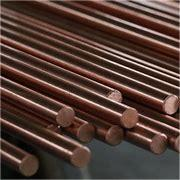1. Introduction
Just 24 hours ago, global copper prices surged past $9,200 per metric ton due to supply chain disruptions in Chile and rising demand from renewable energy infrastructure—making the choice of copper products more critical than ever. Whether you’re grounding an electrical system, welding copper components, or stripping wire for scrap, understanding the nuances between copper rod types and copper strip variants can save time, money, and performance headaches.

In this deep-dive guide, we break down seven essential categories of copper rods and strips, comparing their composition, applications, advantages, and current market dynamics—including earthing rods, brazing rods, welding rods, and flat copper strips. Let’s cut through the confusion and find the best fit for your project.
2. Copper Rods for Electrical Earthing and Grounding
When it comes to safety in electrical systems, the copper earth rod (also called earthing rod copper or ground rod copper) is non-negotiable. These rods channel fault currents safely into the earth, preventing equipment damage and electrocution risks.
Two dominant types dominate the market: solid copper rods and copper-bonded alternatives. Solid copper rods offer superior conductivity and corrosion resistance but come at a premium price. In contrast, copper bonded earthing rods—made from copper bonded steel or copper clad steel earth rods—deliver 90% of the performance at half the cost. The copper layer (typically 0.25mm thick) is molecularly bonded to a high-strength steel core, offering mechanical durability while maintaining good conductivity.
- Copper bonded ground rod: ideal for rocky or high-resistivity soils where driving depth matters.
- Solid copper rod: best for corrosive environments like coastal areas or chemical plants.
Pricing varies widely: earthing rod price for a 16mm x 3m solid copper rod can exceed $120, while a copper clad ground rod of the same size may cost $50–$70. Always verify conductivity specs and coating thickness before purchasing.
3. Copper Rods for Joining and Fabrication
Not all copper rods are for grounding—many are engineered for joining metals. Copper brazing rod and copper welding rod serve distinct purposes despite overlapping terminology.

Copper to copper brazing rods (often phosphorus-copper alloys) melt at lower temperatures (600–800°C) and flow into joints via capillary action—perfect for HVAC, plumbing, and electrical busbars. They don’t melt the base metal, preserving structural integrity.
On the other hand, copper rod for welding—such as copper to copper welding rod or welding rod copper—is used in arc or TIG processes where the rod becomes part of the weld pool. These are typically deoxidized copper with added tin or silicon for strength. Copper rod welding is common in marine and industrial repairs but requires skill due to copper’s high thermal conductivity.
Key tip: For DIY plumbing or AC line repairs, brazing is safer and more accessible than welding. Use copper brazing rods with flux for leak-free joints on aircon copper pipe or copper pipe for AC systems.
4. Copper Strips: The Flat Power Carriers
Beyond rods, flat copper strips—like copper strip for earthing, beryllium copper strip, or nickel plated copper strip—are vital in switchgear, transformers, and grounding grids. Their wide surface area reduces resistance and improves heat dissipation.
Common variants include:
- Flat copper strip (e.g., 25x3mm): standard for earthing grids; copper earth strip 25x3mm price hovers around $8–$12 per meter.
- Beryllium copper strip: high strength + conductivity; used in springs and connectors.
- Thin copper strips (1mm copper strip): ideal for electronics and flexible busbars.
Copper strip price depends on purity, temper, and plating. A roll of copper strip (50m, 20mm wide) can cost $150–$300. Search ‘copper strip near me’ for local suppliers to avoid shipping heavy rolls.

5. Copper Round Bars vs. Rods: What’s the Difference?
Many confuse copper round bar with standard copper rod—but the distinction lies in tolerance and application. Copper round bar (or round bar copper) is precision-machined with tight dimensional tolerances, used in bearings, shafts, or CNC parts. Standard copper rod has looser specs and is cheaper, suited for grounding or melting into ingots.
Both fall under ‘rod copper’ colloquially, but engineers specify ‘bar’ when mechanical properties matter. Flexible copper bar and flexible copper bus bar are specialized offshoots for dynamic electrical connections in generators or EVs.
6. Stripping Copper Wire: Profit vs. Practicality
With copper scrap prices climbing, many ask: is stripping copper wire worth it? Absolutely—if done right. Burning copper wire for scrap is illegal in most regions and destroys insulation value. Instead, use mechanical strippers for the best way to strip copper wire.
For thick cables, invest in a cable stripper; for long runs, automatic wire strippers offer the fast way to strip copper wire. Always separate copper strip wire from aluminum to maximize scrap value. Remember: stripping wire for recycling yields 20–30% more profit than selling insulated cable.
7. Copper Pipes and Tubing: Not Rods, But Related
While not rods, copper pipework (including 15mm copper pipe, 22mm copper tube, and aircon copper tube) often shares supply chains and pricing trends with copper rods. AC copper pipe price has risen 12% this month due to HVAC demand spikes.
Key tip: When resoldering copper pipe or bending copper pipe, use compatible copper pipe fittings and clean joints thoroughly. PEX plumbing pipes are replacing copper in some residential apps, but copper remains king in commercial AC and high-pressure systems.
8. Conclusion
From copper bonded steel earthing rods to beryllium copper strips and copper to copper brazing rods, the copper rod ecosystem is far more diverse than it first appears. Your choice should balance conductivity, corrosion resistance, mechanical strength, and budget—especially as copper prices fluctuate. Whether you’re installing a grounding system, repairing an aircon line, or prepping scrap, knowing these seven categories ensures you pick the right copper product every time.
Our Website founded on October 17, 2012, is a high-tech enterprise committed to the research and development, production, processing, sales and technical services of ceramic relative materials such as 7. Our products includes but not limited to Boron Carbide Ceramic Products, Boron Nitride Ceramic Products, Silicon Carbide Ceramic Products, Silicon Nitride Ceramic Products, Zirconium Dioxide Ceramic Products, etc. If you are interested, please feel free to contact us.

